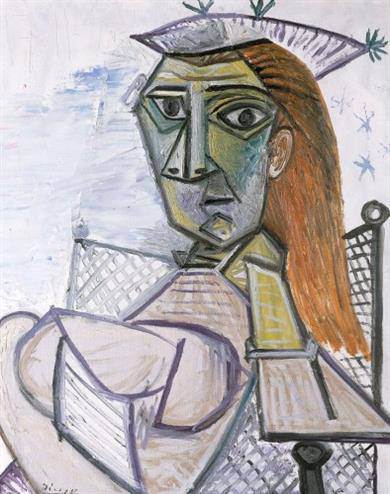
Pablo Picasso
Woman Sitting in an Armchair (Femme assise dans un fauteuil), 1941.
Oil on canvas, 73 x 60 cm
Henie Onstad Kunstsenter, Høvikodden, Norway
© Henie Onstad Art Centre, Norvège/Photo Øystein Thorvaldsen
© Succession Picasso 2013
L’Art en guerre. France, 1938-1947, Guggenheim Bilbao On view at the Guggenheim Museum Bilbao, ‘L’Art en guerre. France, 1938-1947: From Picasso to Dubuffet’ reveals how art was used to respond to the dramatic and complex situation in France between 1938 and 1947.
March 16 – September 8, 2013.
]]>
Source: Guggenheim Museum Bilbao
“L’Art en guerre” can be seen as an exploration of the relationship between art andwar carried out through a wide selection of documents and works, whose authors include some ofthe most famous names of the 20th century. The pieces created over the course of those yearsreflect very different aspects of the daily reality of those who lived through that period: theirdreams, nightmares, and hopes—in short, the cognitive, creative and emotional atmosphere thatmade life meaningful in different sectors of society. Yet that context of social chaos and spiritualdarkness was also a productive and innovative time for art, which survived everywhere and flowedforth in all variety of circumstances, both as an underground trend and within the parameters ofofficial taste.
In the face of adversity, many artists continued working until the very end withwhatever they could lay their hands on, and there were also gallerists who did not hesitate tosupport modern art even in those dark and dramatic times.
The theoretical reflection at the heart of L’Art en guerre grants art history a more general, almostanthropological dimension or packaging, and the documents uncovered in the process of conductingresearch for this show shed new light on the turbulent history of that era. We trust that theexcellent results of this concentrated effort will allow visitors not only to enjoy singular artisticcreations but also to expand and enrich their vision of the complex, dramatic period in which theywere created, thus facilitating a more thorough understanding of recent European history from theperspective of art.
The exhibition is divided into twelve sections: History, The Official Taste; The Surrealists; The Camps; Exile, Refugees, and Concealment; Masters of Reference and the Young Painters in the French Tradition; Picasso in His Studio; Galerie Jeanne Bucher; Camps and Prisons; The Liberation; Decompressions; and The Anartists.
Related content
Egon Schiele, from Albertina to Guggenheim Bilbao (exhibition, 2012)
Follow us on:


